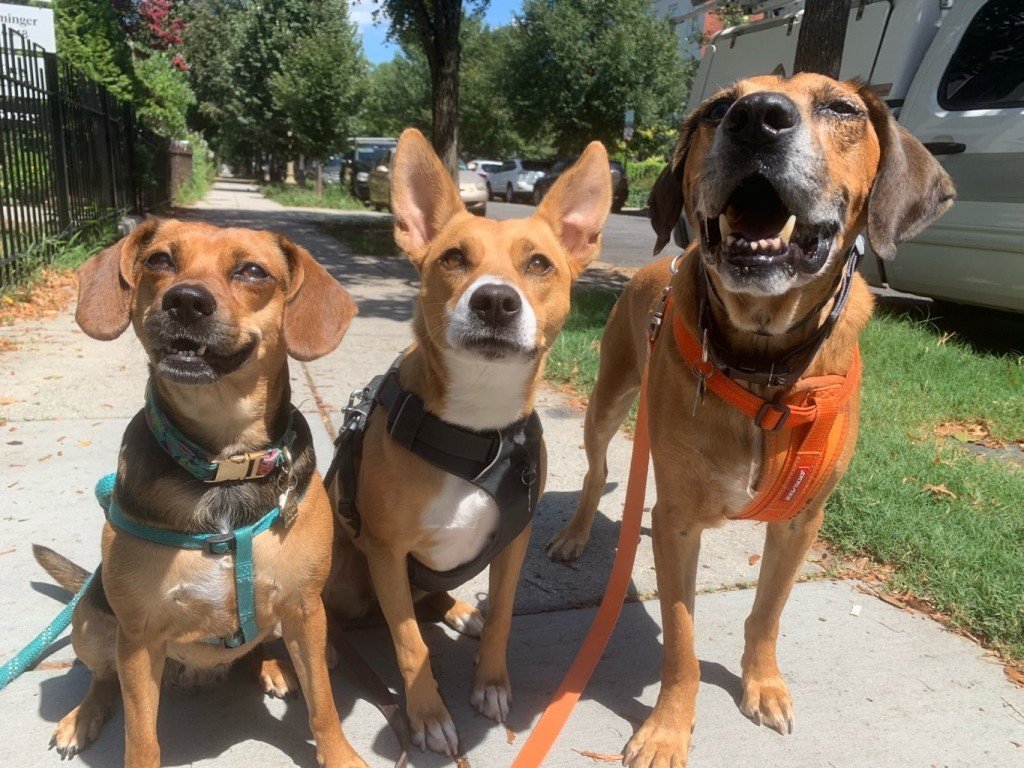It’s no secret that we strongly believe sharing your home and your life with a dog is a wonderful and rewarding experience. But we also know that it comes with challenges for both you and your dog. To make sure you get the most out of life with your pup, we’re sharing our favorite how-tos, tips, and tricks that every dog parent should know. Be sure to check back monthly for new educational content.
For pet parents living in a city environment, walking the dog is a constant. In fact, for some of us, it might be the only aspect of life that’s remained unchanged lately. Beyond the utilitarian nature of walking your dog to answer nature’s call, going out for a walk with the dog can and should be a fun experience for you both.
However, neither of you will enjoy the walk if it always comes with a side of pulling and tripping. That’s why choosing the right leash for your pup is so important—no one wants every venture outside to become a battle. Read on to learn more about the different types of leashes and find out which may be the best fit for you and your dog.
Which Leash Type is Best for You and Your Dog?
Leashes come in a dazzling array of varieties: long, short, rope, leather, reflective, patterned, monogrammed, and even bedazzled. It can be overwhelming! With so many choices, it’s easier than ever to express your taste and personality (or your dog’s) with this common accessory. But, aesthetics aside, the best leash is the one that works for you and your pup.
Standard Nylon Leash
This easily the most common type of leash and with good reason. Nylon leashes are lightweight, relatively durable, and generally inexpensive. They also come in a variety of colors, widths, and can even have patterned canvas or ribbon sewn on to make a fun statement accessory for you and your pet. You can also easily find nylon leashes with reflective detailing to provide added safety and visibility for you and your pup on nighttime walks.
Nylon leashes are generally comfortable to hold; though it’s worth nothing that width affects the leash’s comfort greatly (more on that later). Additionally, nylon isn’t water-resistant, meaning your pup’s leash can become dirty pretty fast. Thankfully, most nylon leashes can be easily handwashed with some warm water and dish soap.
Finally, it’s worth noting that nylon leashes are not the best choice for dogs who tend to chew on their lead. While leash biting is a behavior that shouldn’t be encouraged, you may want to avoid this material while your dog is still learning good leash behavior.
Leather Leashes
Leather is a sophisticated choice and can be a long-lasting option if cared for properly. That said, leather is expensive and does require some care. So, if you’re not up for regularly cleaning and treating the leather to prevent cracking and splitting, then this might not be the pick for you.
It’s also worth noting that leather’s cost and need for regular care mean it might not be a great choice for puppies with curious (and sharp!) teeth or for vigorous outdoor activities like hiking and swimming. This type of leash is best for regular daily walks with dogs who have mastered polite leash walking skills.
Rope Leashes
Increasingly popular, leads made from mountain climbing rope offer a durable option for leash chewers (though not totally indestructible), and the material itself can be more comfortable for pet owners. There’s a bit of natural give in the rope, which makes pulling less painful for your arm and shoulder. Many rope leashes also come with reflective material woven directly into the rope, making them a great option for nighttime walking.
Vegan “Leather” Leashes
The variety of leashes made from durable, animal-free materials is increasing every day. Besides satisfying the preference of many owners for a vegan leash option, these styles can offer greater water-resistance and durability when compared to regular leather. Plus, the range of colors allows you to have some fun with your leash choice.
It’s worth making sure you buy a product works as good as it looks though. The best vegan “leather” leashes will be made from a synthetic coating over a durable and flexible woven fabric, like those made from BiothaneÆ. This construction makes them comfortable to hold, but it also ensures the leash lasts for the long haul.
A Note about Retractable Leashes
Although the idea of a retractable leash sounds great in principle, they tend to cause more problems than they solve. First, the very design of a retractable leash teaches dogs that pulling is the way to get what they want. The dog pulls and more length becomes available, sending a signal that tugging on the leash is rewarded with more freedom.
Beyond the mixed messages provided by a retractable leash, this style also presents some dangers to both dogs and humans. The generally thin cords can easily break when subjected to great sudden force—like a big dog running fast and reaching the end of the rope. However, despite its lack of durability, that thin cord isn’t completely innocent. It can cause burns or cuts on any legs (human or furry) caught in its path.
The bulky construction of retractable leashes means you can’t wrap the leash around your hands, nor can you slip it over your wrist. This means you’ll be limited to the use of just one hand for every walk, making simple tasks like picking up waste or opening the door harder to do while still maintaining control on your pup.
Finally, retractable leashes don’t provide much control for the owners since, once the dog has extended the length, there isn’t much you can do to reel them back in. This creates a variety of potentially bad situations, ranging from a dog running into the street or around a corner before you’ve caught up to a dog suddenly rushing up to humans and other dogs you may encounter. These sudden greetings aren’t only rude, but they can be quite dangerous too. Leash greetings should always be supervised and well-managed.
For the reasons above, we do NOT recommend retractable leashes as an option for most dogs and owners.
What Else to Look for When Choosing a Leash
Aside from the material itself, there are a few other things to think about when you’re shopping for your pup’s leash. Leash length, thickness, and the presence of a few helpful features may all contribute to the enjoyment you and your pup get from your walks.
Leash Thickness
How comfortable a leash feels in your hand is often directly related to how wide or thin it is. Thinner widths (those under 1/2”) are more flexible and lighter weight, but they can also more easily cut into your hands and cause leash burn. Thicker widths are more durable but come with added weight and bulk that may make them less flexible and uncomfortable to wrap around your hands. It’s best to let your dog’s size guide your choice.
Thinner leash styles (1/2” or thinner) work best for small dogs who are less likely to pull vigorously and cause leash burn. Though leashes come in thicker widths, it’s generally good to stick to a maximum of 1” for medium to large dogs. This size will let you comfortably hold the leash and won’t weigh your pup down.
Leash Length
Most commercially available leashes will range between 4’ to 6’ in length, and the best choice depends on your dog’s walking style. Does your dog stop frequently on walks to sniff every tree box? Or is your dog a pup on a mission who stops only to potty? Dogs who frequently stop may become easily tangled in a leash that’s too long, and you’ll soon find yourself stooping down to unwind the leash from their legs every half a block. Similarly, dogs who love eating anything and everything they find on the sidewalk may do best with a shorter leash that lessens their chance of getting to a street snack before you can steer them clear.
Different activities can also affect the leash length you choose. If you’re taking your pup hiking, camping, or to a dog-friendly beach, then you may want to invest in a long lead of 15” or more. The extra length gives them room to explore and have fun, while still providing the safety of an on-leash experience.
Other Key Leash Features
Many leashes offer additional features that benefit both you and your dog. One of the most common is a ring or loop for holding a waste bag dispenser. Poop happens, and you might as well be prepared. As a bonus, you can use a carabiner to attach your keys, a water bowl, or a treat pouch to this ring.
Another feature we’ve already mentioned is visibility. Whether the entire leash is reflective, has strategically placed reflective details, or even has flashing lights for nighttime, your leash can be a vital safety choice for you and your dog. Walking in a city at night necessarily means playing it safe around traffic, and these visibility features help ensure cars can easily spot you in the dark.
Speaking of traffic, a traffic loop can be a great feature for many owners. The traffic loop is a second handle or loop further down the leash, about 1.5’ to 2’ from the buckle. This gives you the extra leverage of holding your dog closer and can be extremely useful. From keeping your dog close to you when passing other people and dogs on the street to preventing them from jumping up on counters or benches at the vet’s office, the extra control comes in handy with easily-excited pets and dogs still learning the ins-and-outs of polite leash behavior.
Finally, if you’ve chosen the right leash but are still having a hard time getting your dog to practice proper leash manners, we’re here to help. Our upcoming sessions of adult and puppy group training classes cover the foundations of good leash behavior to set you and your dog up for success. Can’t make it to a group class? We’ve got private training options that offer individualized help for your dog’s specific behavior issues. No matter your needs, we’re here to help make every walk a happy one!


